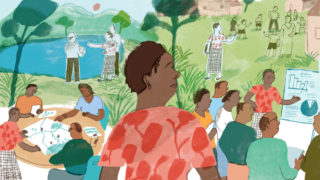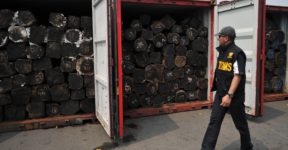
Bridging the Gender Gap in Forest Governance: Practical Lessons from Ghana
Forests can only be managed sustainably when their value and benefits are realized by all segments of society. Evidence suggests that women and men make different use of forests, and have different knowledge and priorities for them. However, in many parts of the world, women who depend on forests are under-represented in forest governance at the local, national and international levels. Their lack of involvement in decision-making leads to a lost opportunity to capture their knowledge and experiences, and undermines efforts for the sustainable management of forest resources. Doreen Asumang-Yeboah, forest governance consultant, outlines the issues.
This has been the case in Ghana, where women’s contribution to the forestry sector and their critical role as major stakeholders has long been ignored. This has constrained their ability to reap adequate benefits from forests, and to optimize their potential as agents of change in society.
With the growing realization of the prevalence of gender inequality in the forestry sector, efforts are now being made from the global to local levels to ensure the effective participation of women in forest governance. Bina Agarwal reports that involving women in decision-making in India resulted in the better conservation of forests. Such involvement, however, is not widespread and there is a need for mainstreaming gender in the sector, especially in tropical countries.
Another study asserts that ‘the integration of gender into the forestry sector is constrained by the perception that forestry is a male-dominated field; lack of clarity among researchers on the concept of gender; and lack of technical skills, interest and awareness on gender’.
Ghana is no exception to this. Since the onset of formal forestry in the country in the early 20th century, forest management has been focused on the exploitation of timber resources. The concentration on timber rather than other forest products resulted in male dominance of the sector, as timber exploitation is perceived to be the preserve of men, and has perhaps contributed to policies and institutions in the sector being gender-blind.
However, the recent global discourse on gender and its impact on the development field have brought an awakening in Ghana’s forestry sector as well as more broadly across the different sectors of the economy. This has raised several questions, such as what are the roles of women and men in forest governance in Ghana, what accounts for this and what is being done to improve the situation.
Ghana’s 1992 constitution mandates all citizens to safeguard the environment, thus inferring that both men and women are responsible for the management of the environment. The constitution also prohibits discrimination on the basis of gender.
The country has also been engaged in the global gender discourse and has ratified international conventions and treaties on gender. Ghana adopted the Affirmative Action Policy in 1998 to enhance the promotion of gender across all sectors of the economy and to promote equity between men and women and the Ministry of Women and Children’s Affairs was created in 2001. Policies to promote gender equality also came into being with the development of the National Gender Policy in 2004 and the Forestry Commission’s Gender Policy of 2004. All these interventions are geared towards gender inclusion in programmes and projects.
Employment statistics provide one indication of the dynamics of gender in Ghana’s forestry sector. Data from the Forestry Commission indicate some change in the proportion of its female staff in recent years, this having risen from 12 per cent in 2014 to 16 per cent in 2018. The proportion of women in management positions has also increased from 7 per cent in 2015 to 12 per cent in 2018. Although this is an improvement, the proportion remains low.
Ghana’s forestry sector continues to be dominated by men. Most women in the sector, especially in government institutions, occupy lower paid and less responsible positions, and are therefore not involved in decision-making processes.
Discussions with a range of people from across the sector (including forestry-school graduates and staff of the Forestry Commission and non-governmental organizations) highlight a range of barriers to women’s full participation in the sector. These can be summarized under two key points: competency and the space to participate.
Competency, in terms of capacity to perform, was identified as the first challenge for women in the sector. Most women, particularly in the government sector, are recruited as junior staff and are unable to rise to senior management positions.
This is mainly as a result of women not pursuing further education and qualifications, a prerequisite for promotion to senior positions. This in turn is because of a lack (both perceived and real) of opportunities for career progression. Exacerbating this, women often have less motivation to consider more challenging roles because of societal expectations that mean they need to balance formal work with family responsibilities.
The other key challenge is space for women to fully participate in decision-making. There remains a lack of recognition and understanding of the role of women in the sector, which means that they are often not allowed to participate. This situation is observable from community through to formal settings, including in government and civil society. For example, a female staff member from a government institution said: ‘I was denied travelling with a team to the field by male colleagues with reason that the work to be executed was a man’s job.’
Furthermore, government is hierarchical and bureaucratic, which requires individuals to have formal qualifications for them to rise through the ranks and to justify their inclusion in decision-making processes. Therefore, there are only a handful of women at the senior level. Civil society in contrast is more flexible, and individuals can be recruited at any level based on competency for the job rather than formal qualifications or length of service. This creates opportunities for young, less experienced men and women to engage in decision-making.
Sometimes, however, although the space is available, it is difficult for women to take advantage of this. For example, many women are primarily responsible for household and family duties and it can be particularly difficult to balance professional and family roles during maternity and nursing. Furthermore, their career is usually expected to take second place to that of their husbands.
This section highlights some of the interventions from government and civil society that have sought to promote gender mainstreaming in the forestry sector in Ghana.
Although the Forestry Commission developed a gender policy in 2004, this document has not been finalized for implementation and remains non-binding. This notwithstanding, some departments and individuals have developed initiatives that seek to promote gender equality.
For instance, the Ghana REDD+ Strategy document, developed by the Climate Change Department, seeks to ensure that men and women are fully recognized as forest stakeholders and have equal opportunities to develop their capacity to participate in, and benefit from, initiatives. The strategy employed is to conduct gender-impact analysis for all projects to understand the situation and to develop safeguards.
Specific initiatives include the development of gender action plans, efforts to ensure at least 30 per cent representation of women in all REDD+ programmes and workshops, and the creation of a REDD+ gender desk to address gender related issues.
At the individual level, the current chief executive of the Forestry Commission, as part of efforts to promote female participation at the decision-making level, appointed the first women directors within the commission – director of operations, in 2017; director for climate change in 2018; and director of human resources in 2019. The director of climate change also became the first woman appointed to the executive management team (EMT). With the expansion of the EMT to include divisional directors, female representation now stands at three out of a total of 21.
Civil society within the forestry sector, through the facilitation of ClientEarth and its in-country partner the TaylorCrabbe Initiative, gathers periodically to learn and discuss legal issues of relevance to the sector.
This platform, the Legal Working Group (supported by the UK Department for International Development under the Forest Governance, Markets and Climate programme) has been operational since 2013. It has about 30 participants from different organizations across the country, with about 30 per cent being females. ClientEarth and the TaylorCrabbe Initiative came up with a number of innovations to promote gender mainstreaming within the sector, as outlined below.
The Legal Working Group (LWG) introduced a gender session as part of its meetings, in order to improve understanding of the subject of gender among its participants (both men and women). This session aims to enlighten members on gender dynamics in the forestry sector so they can be factored into the development and implementation of activities of the respective organizations. This process has resulted in some concrete changes.
For example, the LWG includes gender considerations in the appointment of representatives from civil society organizations to boards and committees, which led to the appointment of a female representative on the steering committee of the Cocoa and Forest Initiative. In addition, member organizations have begun to consider gender in their recruitment processes and they are also capturing gender-disaggregated data to understand the situation within their project areas and to design their interventions. This has resulted in some organizations changing the time for community engagements to enable the participation of women, as well as young people and children.
Participants of the LWG meetings were mostly men and occupied management positions in their organizations. Therefore, there was a need for innovative approaches to reach out to women. The provision of targeted training for women therefore came up as an extension of the LWG meetings. This training draws members from civil society, the private sector, the media and government. As well as face-to-face trainings, beneficiaries come together through a social media platform, enabling them to share information and to provide advice and support.
In a related development, the Nature and Development Foundation together with the Kumasi Wood Cluster, as part of the implementation of a project to build capacity among small and medium-sized forest enterprises in Ghana and Liberia, is developing the capacity of women in the timber industry. This initiative seeks to establish supportive networks for women and to enable them to have a stronger voice in decision-making.
Inviting women to meetings does not guarantee their participation, especially when they have parental roles to play. Women in such situations either do not attend meetings or participate passively as a result of having to care for their children.
One innovation by ClientEarth and the TaylorCrabbe Initiative has been the provision of child-care support for parents of young children. This facility enables them to participate actively in LWG meetings by taking on the cost of childcare (boarding, lodging and transport). While no single initiative can take the entire credit, the number of women present in the most recent LWG in 2020 has increased compared to previous years.
Gender is key in forest governance but the forestry sector in Ghana continues to be male dominated. There is a need for conscious efforts to mainstream gender at all levels. Although government and civil society are making efforts to increase the number of women involved in decision-making in the sector, representation is not enough. Further efforts are required to remove barriers to women’s effective participation and the inclusion of their views in the decision-making process. Civil society is doing well in this regard, and learning and sharing between government and civil society should be encouraged to promote best practices for the effective implementation of gender-mainstreaming initiatives.

